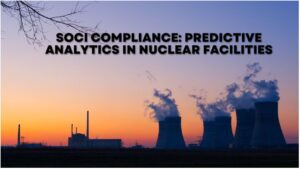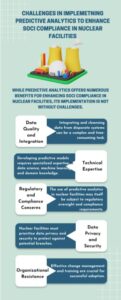
In the highly regulated and consequential realm of nuclear facilities, ensuring stringent compliance with Security of Critical Infrastructure (SOCI) standards is paramount. Non-compliance in this domain can have severe repercussions, ranging from potential safety risks to substantial legal penalties. Consequently, nuclear operators continuously seek innovative solutions to proactively bolster their compliance measures.
Predictive analytics, an emerging technology, is revolutionizing how nuclear facilities maintain and enhance SOCI compliance. Predictive analytics empowers facilities to identify potential compliance breaches before they occur by harnessing the power of data science and artificial intelligence, enabling them to take preemptive action and mitigate risks effectively.
The Necessity of SOCI Compliance in Nuclear Facilities
Adhering to SOCI standards is a non-negotiable obligation for nuclear facilities, as these regulations are designed to safeguard against accidents and maintain the integrity of operations. Failure to comply can lead to dire consequences, including severe safety hazards and substantial legal penalties that could cripple an organization.
The U.S. Nuclear Regulatory Commission (NRC) outlines that consequences of non-compliance in nuclear facilities can vary from financial penalties and increased oversight to the revocation of operating licenses, effectively shuttering operations. A prime example of the gravity of non-compliance is the Fukushima Daiichi nuclear disaster in 2011, which was exacerbated by inadequate safety measures and regulatory violations.
In essence, SOCI compliance is not merely a bureaucratic exercise but a critical component that underpins the safe and responsible operation of nuclear facilities, making it an indispensable priority for industry stakeholders.
Role of Predictive Analytics in SOCI Compliance
Traditionally, nuclear facilities have relied on reactive measures to address compliance issues, often responding to incidents or audits after the fact. The SOCI Act regulates critical infrastructure assets in the energy sector, which could include nuclear facilities if they are deemed critical to the nation’s energy supply and security. However, predictive analytics offers a proactive approach that can identify potential compliance breaches before they manifest, empowering facilities to take preventive action and mitigate risks more effectively.
How Predictive Analytics Works
Leveraging advanced statistical techniques, machine learning algorithms, and data mining, predictive analytics analyzes vast amounts of operational data from nuclear facilities. This data can include sensor readings, equipment performance metrics, maintenance records, and a myriad of other sources.
By uncovering patterns and correlations within this data, predictive models can accurately forecast future events or conditions that may lead to compliance violations. For instance, if left unchecked, anomalies in equipment performance detected by a predictive model could potentially result in a safety breach.
Benefits of Predictive Analytics in Nuclear Facilities
Early Detection of Compliance Risks: By anticipating potential issues before they occur, predictive analytics enables nuclear facilities to take proactive measures, minimizing the likelihood of non-compliance and associated risks.
Enhanced Safety Measures: Predictive models can identify potential safety hazards, allowing facilities to address them promptly, thereby reducing the risk of accidents and enhancing overall safety.
Optimized Resource Allocation: By pinpointing high-risk areas, predictive analytics helps nuclear facilities prioritize their compliance efforts and allocate resources more efficiently, maximizing their return on investment.
Improved Decision-Making: The insights generated by predictive analytics provide valuable data-driven insights, enabling nuclear facility operators to make informed decisions regarding compliance measures, maintenance schedules, and operational strategies.

Enhancing SOCI Compliance Through Technology
As predictive analytics continues to evolve and gain traction in the nuclear industry, emerging trends and advancements in related technologies are poised to further enhance SOCI compliance in nuclear facilities.
The Rise of Artificial Intelligence (AI) and Machine Learning (ML)
AI and ML are at the forefront of technological advancements that can revolutionize how nuclear facilities approach compliance. These technologies can enable more sophisticated predictive models, capable of handling complex, multi-dimensional data and identifying intricate patterns that may be overlooked by traditional analytical methods.
For instance, deep learning algorithms can be trained on vast amounts of operational data to detect subtle anomalies or deviations from normal behavior, providing early warnings of potential compliance issues. Additionally, natural language processing (NLP) techniques can be applied to analyze textual data, such as maintenance logs and incident reports, to uncover valuable insights and correlations.
Internet of Things (IoT) and Sensor Technology
The proliferation of IoT and advanced sensor technology is enabling nuclear facilities to collect more comprehensive and granular data than ever before. Providing a wealth of data, these technologies, from real-time monitoring of equipment performance to environmental conditions, can be leveraged by predictive analytics for enhanced SOCI compliance.
For example, wireless sensor networks can be deployed throughout a nuclear facility to continuously monitor radiation levels, equipment vibrations, and other critical parameters. Predictive models can then analyze this data to proactively identify potential safety or compliance risks.
Augmented Reality (AR) and Virtual Reality (VR)
While not directly related to predictive analytics, AR and VR technologies are poised to play a supporting role in enhancing SOCI compliance in nuclear facilities. These technologies can be used for immersive training simulations, allowing personnel to practice compliance procedures and safety protocols in a risk-free virtual environment.
Additionally, AR can be leveraged for real-time visualization of predictive analytics outputs, providing maintenance technicians with vital information about potential issues overlaid on their physical workspace. This can streamline maintenance activities and enhance situational awareness, ultimately contributing to improved compliance and safety measures.
Comparison Table: Traditional Compliance vs. Predictive Analytics-Driven Compliance
| Aspect | Traditional Compliance Approach | Predictive Analytics-Driven Compliance |
| Methodology | Reactive, based on historical data and periodic audits | Proactive, leveraging advanced analytics to anticipate potential issues |
| Risk Identification | Limited to known risks and past incidents | Identifies emerging risks and unknown patterns through data analysis |
| Response Time | Delayed, responding after issues have occurred | Near real-time, enabling immediate preventive action |
| Data Utilization | Limited to structured data sources | Leverages diverse data sources, including unstructured data |
| Scalability | Limited by manual processes and human resources | Highly scalable, leveraging computational power and automation |
| Continuous Improvement | Reliant on periodic reviews and audits | Enables ongoing monitoring and continuous improvement cycles |
| Resource Optimization | Inefficient, with potential resource misallocation | Optimized resource allocation based on data-driven insights |
As evident from the table, the predictive analytics-driven approach to SOCI compliance offers numerous advantages, including proactive risk identification, real-time responsiveness, improved data utilization, scalability, and optimized resource allocation. By embracing this approach, nuclear facilities can enhance their compliance measures, mitigate risks more effectively, and foster a culture of continuous improvement.
FAQs
1. How secure are nuclear facilities?
Nuclear facilities are designed with multiple layers of physical and cybersecurity measures to protect against potential threats. Robust safety systems, strict access controls, and rigorous training protocols are implemented to ensure the safe operation of these critical infrastructures.
2. Why is compliance required in nuclear facilities?
Compliance with regulatory standards is mandatory in nuclear facilities to maintain strict safety protocols, minimize risks, and prevent accidents or incidents that could have severe consequences for public health, the environment, and national security.
3. What is predictive maintenance in power plants?
Predictive maintenance in power plants involves monitoring the condition of equipment and systems to identify potential issues before they occur. This proactive approach uses data analysis and condition monitoring techniques to optimize maintenance schedules, reduce downtime, and extend the lifespan of critical assets.
Conclusion
In the high-stakes domain of nuclear facilities, ensuring strict adherence to SOCI compliance standards is not merely a regulatory obligation but a moral imperative. Predictive analytics, with its ability to anticipate potential compliance breaches and safety hazards proactively, has emerged as a game-changing solution for the industry.
By harnessing the power of data science, machine learning, and advanced analytics, nuclear facilities can unlock a new level of operational excellence, fostering a culture of continuous improvement and enhancing public trust in the industry.

